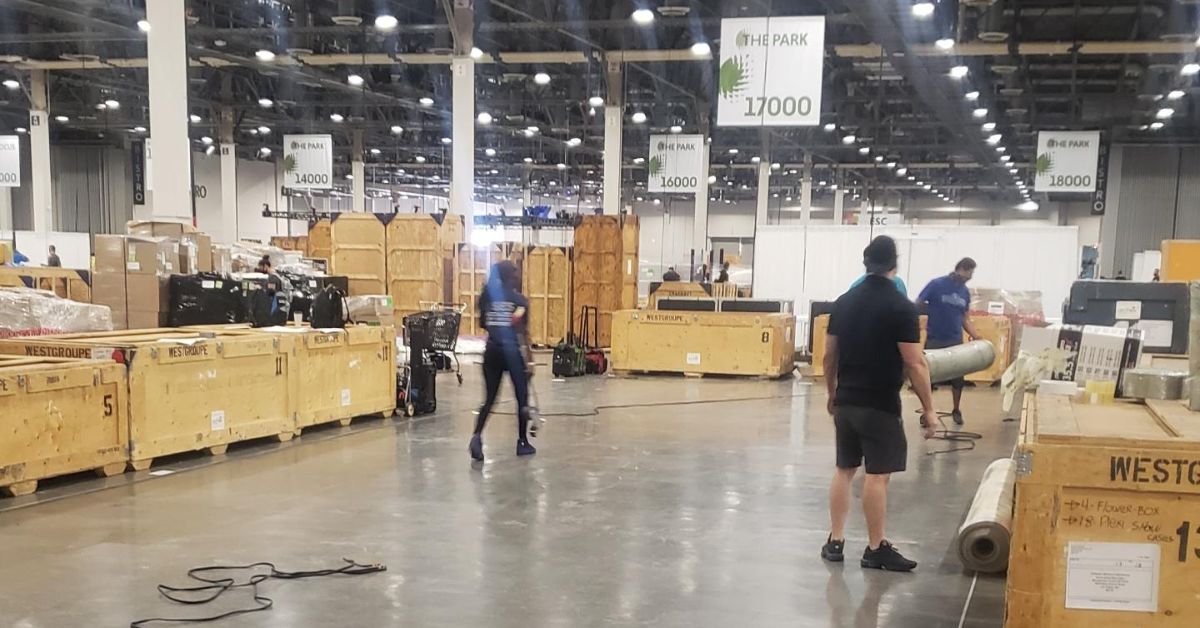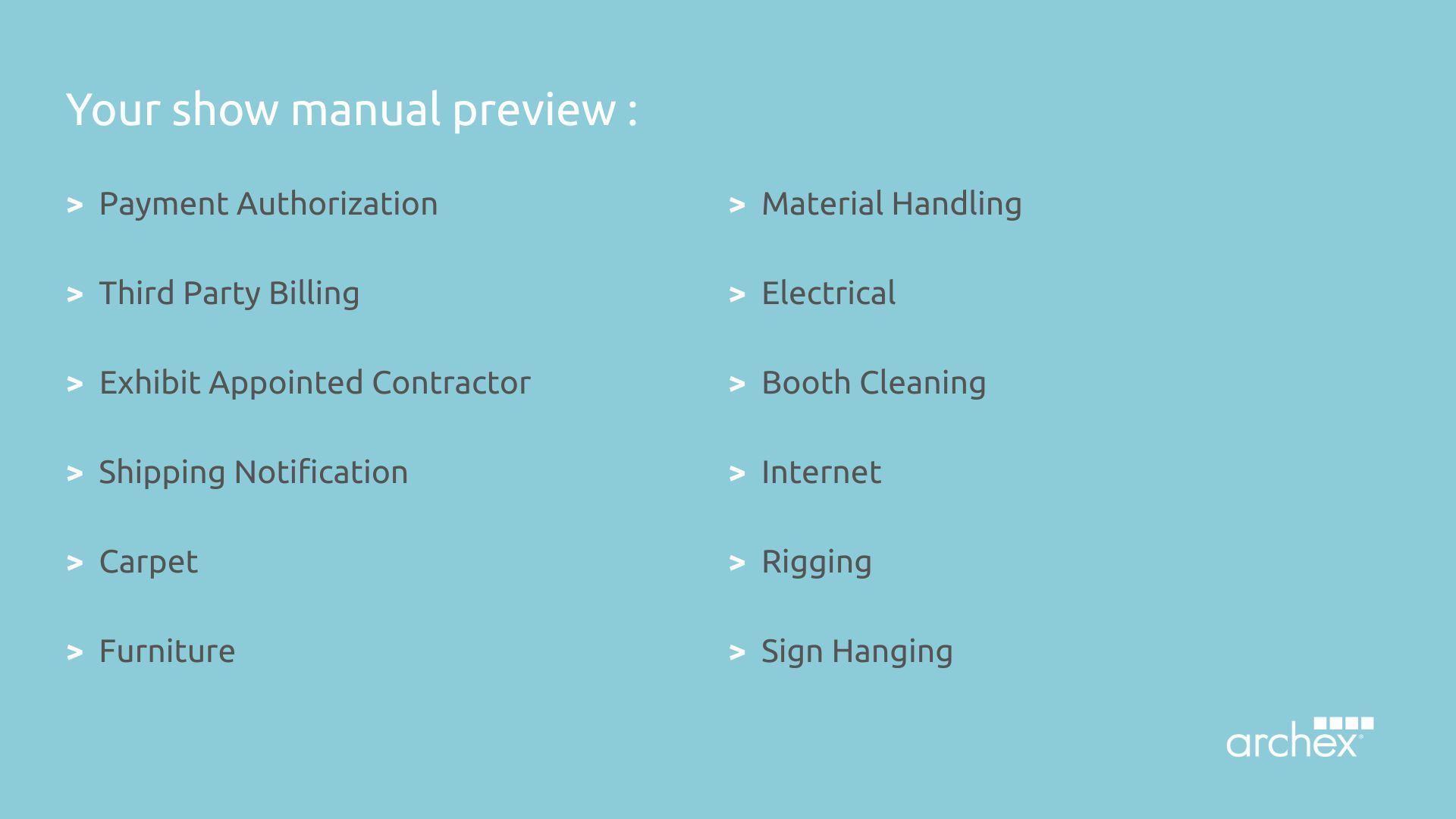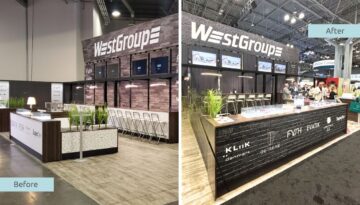How to Survive Tradeshow Planning: A Practical Guide for Exhibitors
Planning a tradeshow is not for the faint of heart. Just when you think you’ve handled booth design, shipping, travel, and hotels, along comes the Show Services Manual. Hundreds of pages, dozens of forms, and enough fine print to make even seasoned exhibitors reach for the Tylenol.
To help you survive, we’ve broken Show Services into an easy survival guide that breaks down the essentials of successful tradeshow management.
1.Tradeshow Paperwork and Payment Forms Every Exhibitor Must Complete
Before you can order anything, you’ll need to deal with the financial side.
Payment Authorization: Every service provider requires your payment details. Expect to complete multiple forms if services are provided by different vendors. Correctly submitting these forms guarantees that your tradeshow services are processed on time.
Third-Party Billing: If your exhibit house (like Archex) manages orders for you, this form allows billing to flow through them. This is often the easiest option, as your exhibit partner is familiar with tradeshow ordering procedures and deadlines. Of course, you will pay a markup from your exhibit house but the savings in time and aggravation is often worth the investment
Survival Tip: Keep all payment and billing forms organized in one central location. Losing track of deadlines or missing submissions can result in additional fees or delayed services, so staying on top of your tradeshow paperwork is essential for a successful show. You will be glad to learn that most show manuals have a calendar of deadlines including discount periods.
2.Tradeshow Logistics and Freight: How to Get Your Booth to the Show Floor
Moving your booth materials is one of the trickiest parts of tradeshow logistics. Proper planning ensures your exhibit freight arrives on time and your booth is ready for the show.
Advance Warehouse: Shipping booth properties to the Advance Warehouse ensures that it will be at your booth on time for the installation. This often comes with a premium cost but can be a saving if labor is delayed waiting for freight. You will also need to be prepared to ship earlier. Planning is essential.
Direct to Showsite: Shipping materials direct to the convention centre to arrive at the last minute can save a few dollars but you run the risk of transport delays, waiting time for offloading and potential waiting time for your exhibit house labor.
Move In Target: You will be assigned a specific date and time your booth can install. If you are given weekend target expect to pay a premium for overtime labor. You can often ask for your target to be changed by completing a Target Change Request Form.
Outbound Target: You will likely be assigned an outbound target date and time. Planning can save time and costs. Your exhibit house can assist with meeting this deadline.
Shipping Notification: This form alerts the show of your incoming and outgoing booth materials and freight. Skipping this step can lead to forced freight therefore extra costs.
Congrats, your exhibit materials made it to the convention center! But don’t pop the champagne just yet, they still need to find their way to your booth.
Material Handling (Drayage): Charged by weight, typically in 100 lb. increments, drayage is one of the most common surprises for exhibitors. Always ask your exhibit builder for accurate weights to avoid unexpected costs.
Survival Tip: Treat tradeshow logistics like air travel. The more organized your paperwork and shipping information, the smoother your booth setup will be on-site.
3.Tradeshow Booth Setup and Presentation: Carpet, Furniture, and Cleaning Tips
Before your tradeshow booth hits the floor, make sure it’s professional and inviting. Attention to booth design, furniture, and cleanliness can greatly influence visitor impressions.
Carpet and Flooring: You can order carpet from the show or ship your own. Show-supplied carpet is convenient but usually much more expensive, less comfortable and lower quality than your exhibit builder can provide Proper flooring helps create a polished, professional look. Ask your exhibit house for the best option be it carpet, vinyl flooring, printed flooring or a raised floor.
Furniture: Rental tradeshow furniture directly from the show works well for large setups. For smaller orders, better quality, and a designer look and feel, renting tradeshow furniture through your exhibit house (like Archex) is often the better route. It also gives you more variety. Tables, chairs, and counters all affect how visitors perceive and experience your booth.
Booth Cleaning: Overnight cleaning or porter services keep your space tidy and professional throughout the event.
Survival Tip: Tidy flooring, exciting furniture, and an organized booth can leave a lasting positive impression on visitors. Tradeshow furniture is a direct reflection of your companie’s values.
4.Tradeshow Electrical and Internet: Essential Booth Technology for Exhibitors
Electricity and internet are two services no exhibitor can skip when planning a tradeshow booth. Proper setup ensures your lights, screens, and technology run smoothly throughout the event.
Electrical Power: All booths require electricity for lighting, screens, equipment, and product samples. Order early to take advantage of discounted rates and confirm outlet placement before flooring is installed.
Internet and Connectivity: Both wired and Wi-Fi connections are available, but expect premium pricing. Costs can easily exceed your monthly home internet bill in a single day, so plan accordingly.
Survival Tip: Double-check outlet and network placement diagrams with your team before installation. Adjusting electrical or internet connections after the floor is down can be costly and time-consuming.
5.Booth Rigging and Hanging Signs: Tradeshow Setup Essentials
If your tradeshow booth includes large hanging elements, you’ll need to coordinate with specialized rigging and sign-hanging crews. Proper planning ensures safety and avoids unexpected costs.
Rigging: Required for lighting trusses, heavy structures, or suspended elements. This service uses specialized crews and equipment to safely support your booth’s design.
Sign Hanging: Typically handled by in-house teams at the venue. Requires detailed structural drawings and clearly marked rigging points. Costs often surprise first-time exhibitors, so planning ahead is key.
Survival Tip: When permitted by the convention center, ship your own hardware, such as cables and shackles. Renting onsite can be extremely costly, much like paying airport prices for jewelry.
Final Advice: How to Survive Tradeshow Planning Without the Stress
Navigating tradeshow services takes time, patience, and careful attention to detail. The best way to stay on top of deadlines and avoid costly mistakes is to work with an experienced exhibit partner who understands the ins and outs of booth logistics, paperwork, and approvals. Learn everything you need to know on show management right here.
At Archex, we handle every form, submission, and deadline on your behalf, so your team can focus on what matters most: engaging visitors, showcasing your brand, and maximizing results from your tradeshow booth.
The Ultimate Tradeshow Services Checklist
Success at a tradeshow starts with preparation. From booth design to logistics, stay on track with our Ultimate Tradeshow Services Checklist, ready to download now.
Ready to make your next tradeshow stress-free and successful?
Contact Archex today to discuss how our expert team can manage your booth setup, show services, and logistics from start to finish.
Frequently Asked Questions (FAQ) About Tradeshow Services
Here are some of the most common questions exhibitors ask us about tradeshow services and our straight-to-the-point answers.
Q: Are there any hidden costs at a tradeshow?
A: Yes. The biggest surprise for most exhibitors is material handling, also called drayage. This fee is charged by weight (usually in 100 lb. increments) to move your booth freight from the loading dock to your exhibit space. To avoid sticker shock, ask your exhibit builder for accurate crate weights and budget for this cost ahead of time.
Q: Should I rent equipment and furniture from the show or my exhibit house?
A: Yes and no. It depends on your needs. For large quantities, renting from the show can save on handling fees. But for smaller orders, your exhibit house (like Archex) will provide quality, variety, and lower costs. A hybrid approach could sometimes be best, large orders from the show, specialty pieces through your exhibit partner.
Q: What exactly is a Show Services Manual?
A: The Show Services Manual (sometimes called the Exhibitor Kit) is your playbook for the event. It includes all the forms, deadlines, rules, and costs for essential services like electricity, internet, rigging, and cleaning. Staying on top of it prevents missed deadlines, late fees, or costly last-minute fixes.
Q: When should I start planning tradeshow services?
A: 3 to 6 months before the show, ideally. Early planning gives you time to submit forms by discount deadlines, confirm logistics, and coordinate with vendors. The earlier you start, the less stressful (and costly) the process will be.
Q: Can an exhibit partner, like Archex, simplify my tradeshow planning?
A: Yes. An exhibit partner takes the burden off your team by handling all paperwork, approvals, and deadlines. At Archex, we coordinate logistics, shipping, installation, and onsite services so your booth is ready to go, leaving you free to focus on connecting with visitors and achieving your event goals.
Ready to make your next tradeshow stress-free? Contact us today and let’s get started.




